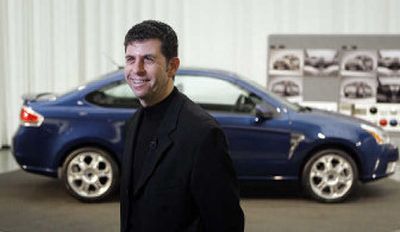Ford focuses on survival

DEARBORN, Mich. — The challenge from Ford Motor Co.’s top brass was daunting: Take an old car and a bland one and make them better. Don’t change their basic frames and footprints, but make them look and feel new. And by the way, the future of the company is at stake, because if they don’t sell, the automaker could run out of money.
That’s what Ford designers and engineers faced when they set out to update the aging Focus small car and the slow-selling Five Hundred full-sized sedan.
The company will unveil new versions of both models this week at the North American International Auto Show in Detroit. A lot is riding on them when they hit the showrooms later this year as 2008 models, especially if consumers continue to shift from trucks and sport utility vehicles to cars.
“Certainly there’s pressure,” Lon Zaback, chief designer of the Focus, said recently as he walked around the car explaining its new features. “I don’t feel any anxiety about it at all because I think we’ve done a terrific job.”
Ford has mortgaged its assets to borrow up to $23.4 billion to fund a massive restructuring plan and cover billions in losses expected until 2009. The company, which lost $7 billion in the first nine months of last year, expects to burn up $17 billion in cash during the next two years.
Analysts say the company desperately needs sales to raise cash if it hopes to survive.
The compact Focus, first introduced in 1999, now looks old and clunky. The Five Hundred generally is perceived as good but underpowered and pedestrian.
First the company did market research to figure out what needed to change.
With the Focus, Zaback and the redesign team knew they would be limited by the car’s current architecture in their efforts to modernize the company’s entry in the small car market.
They raised the sheet metal on the sides, shrinking the window size to give it a sloping, sportier look, with horizontal creases in the sheet metal. There’s more chrome on the grille, mimicking Ford’s successful Fusion mid-sized car, and the hood became more rounded.
“The car appears to be a little bit shorter and have shorter overhangs. It has a much more sporty appearance because of some of the proportional things we did with it,” Zaback said.
The interior is simple but modern with nicer seats, lighted cupholders and more expensive materials including a brushed aluminum look for the dashboard and blue instrument lighting.
The new Focus also is among the models to get the optional Ford-Microsoft “Sync” system that integrates cell phones and personal music players into the car’s electronics, something Ford hopes will appeal to younger buyers.
“There’s a night-and-day difference between today’s Focus and the new one. We really improved it,” said Greg Burgess, the vehicle development manager.
While the designers were at work, engineers were busy going over all the existing car’s parts, refining the two-liter four-cylinder engine, steering and suspension. Although horsepower figures weren’t released, Ford said they made the car more powerful while reducing its weight by about 100 pounds. It will be at least as fuel efficient as the current model, which gets 37 miles per gallon on the highway, said Marcio Alfonso, the chief engineer.
The Five Hundred got a less-radical redesign with changes in the front grille and rear lights and fenders to make it look more sporty and more like the Fusion.
The body didn’t change much, but the car gets a modernized interior and a new 3.5-liter V6 engine with 60 more horsepower and a six-speed automatic transmission. It should be as fuel efficient and much quieter than the old one even though its zero-to-60 acceleration time is 1.5 seconds faster, Ford said. Market research showed that buyers thought the old versions were underpowered, Ford said.
It also will get optional electronic stability control, something that should get it back on the Insurance Institute for Highway Safety’s list of safest cars, said Killol Bhuta, the car’s marketing manager.
“It was always good. We just made it better,” Bhuta said.
The Five Hundred, built on Volvo architecture, sold moderately well in 2005, its first full year on the market, but sales nose-dived last year from almost 108,000 to about 84,000.